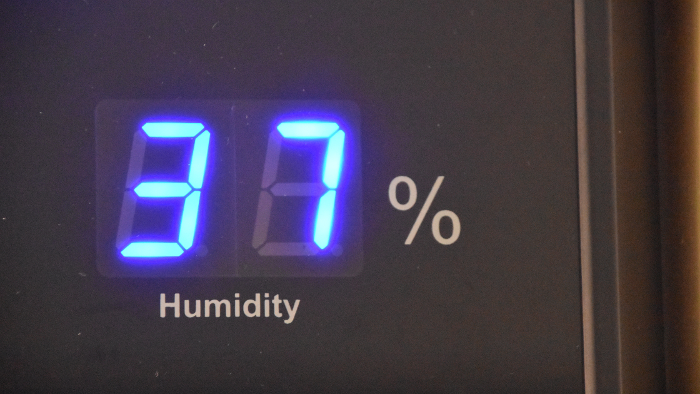Winter brings a chill in the air and a change in our indoor environments. As we crank up the heat to stay cozy, we often overlook a crucial factor: Winter Humidity Levels.
Does humidity rise in winter? Not necessarily. In fact, indoor humidity levels can drop due to heating.
Why does this matter? Humidity levels can significantly affect both your comfort and your furnace’s efficiency. Too low, and you might experience dry skin, respiratory issues, and static electricity. Too high, and you risk condensation, mold growth, and even structural damage to your home.
In this guide, we’ll delve into the dynamics of winter humidity. We’ll explore its effects on your furnace efficiency and provide actionable advice to maintain optimal humidity levels.

Whether you’re a small business owner, a work-from-home professional, or a busy stay-at-home mom, understanding and managing humidity can help you create a more comfortable, healthier, and energy-efficient environment this winter. Let’s dive in.
Does Humidity Rise in Winter?
The question of whether humidity rises in winter is a common one. While the outdoor air can be quite humid depending on your region, indoor conditions tell a different story. When the cold air from outside enters your home, it has low humidity levels due to its low temperature.
Once this cold air is heated indoors, its capacity to hold moisture increases, leading to lower relative humidity indoors. This can make your home feel dry, leaving many to wonder, “Why is my house so dry in winter?”
You might see condensation on windows, which suggests high indoor humidity in certain cases. However, this is typically due to specific daily activities, not an increase in general home humidity. Showering, cooking, and drying clothes indoors can add moisture, temporarily elevating humidity levels.
In most instances, the primary issue during winter is maintaining sufficient humidity levels. The dry air can cause discomfort and negatively impact health. Therefore, understanding and controlling indoor humidity is crucial for comfort and efficiency. Contrary to what you may think, humidity does not rise indoors during winter without specific contributing factors.
The Importance of Maintaining Proper Humidity Levels
Keeping the right humidity level is vital for health and comfort. The ideal range indoors during winter is between 30-50%. This range helps in preventing unwanted physical symptoms and potential damage to your home.
Low humidity can lead to a myriad of problems. Dry skin, chapped lips, and increased static electricity are common nuisances. Moreover, respiratory issues may arise, and you might notice wooden furniture beginning to crack.
Conversely, too much humidity can spell trouble in different ways. High humidity may cause condensation, resulting in mold growth and even structural damage to your house. It can also make the home feel colder, prompting you to crank up the heat, which impacts energy bills. Therefore, balancing humidity ensures comfort and helps in maintaining efficiency.
Ideal Winter Indoor Humidity
For a cozy and comfortable winter indoors, aim for humidity between 30-50%. This range is enough to keep your home environment healthy and pleasant. Maintaining this level ensures that living conditions are optimal without risking damage or discomfort.
When humidity levels are at this ideal range, both your health and home thrive. You can enjoy a snug winter without static shocks or breathing issues. Proper control of indoor humidity not only protects wood furnishings but also mitigates issues like mold growth.
Physical Symptoms of Incorrect Humidity Levels
Humidity plays a significant role in physical comfort. Incorrect levels, whether too high or too low, can manifest in noticeable ways. You might experience dry eyes and skin, frequent coughing, or even nosebleeds as the air’s moisture drops.
If the humidity is too high, you may encounter different symptoms. Musty odors, clammy skin, or worsened allergies could indicate excess moisture. Additionally, mold may develop in corners or on surfaces, potentially harming your respiratory health.
Paying attention to these symptoms aids in addressing and adjusting your indoor humidity promptly. By doing so, you can avoid discomfort and safeguard your health. Recognizing these signs makes it easier to understand what adjustments might be necessary for your comfort and well-being.
How Winter Humidity Affects Your Furnace Efficiency
Your furnace works hard in the winter to keep your home warm. However, the humidity level inside can greatly affect how efficiently it operates. When air is too dry, your furnace might need to work overtime to maintain a warm temperature, making your house feel colder than it actually is.
Conversely, if the indoor air is too humid, it can feel damp and chilly. This often tempts homeowners to raise the thermostat, leading to increased energy usage. Excess moisture can also result in condensation in ductwork, impairing the furnace’s performance.
Balancing humidity is key for optimal furnace efficiency and comfort. Ensuring the air isn’t too dry or too damp helps your heating system function properly. This means a well-balanced home environment, where your furnace operates efficiently without straining itself, keeping your heating costs in check.
The Relationship Between Humidity and Heating Costs
Humidity and heating costs go hand in hand in ways you might not expect. When the humidity is optimal, your perceived warmth increases. This can allow you to lower the thermostat setting, thus reducing energy bills.
On the other hand, inadequate humidity can lead to discomfort. Your natural instinct might be to raise the thermostat, thinking it will provide more warmth. However, this leads to increased heating costs as the furnace works harder.
Maintaining balanced humidity levels within the recommended range helps ensure your home stays comfortable. It also makes heating efficient without unnecessarily spiking your energy expenses. Balancing humidity helps you enjoy comfort without the financial strain.
Common Causes of High Humidity in Homes During Winter
High humidity in winter often surprises homeowners, but it can happen due to various reasons. One common cause is poor ventilation. When fresh air isn’t circulating, moisture from daily activities builds up indoors.
Another factor could be your home’s insulation. While insulation is crucial for warmth, it can sometimes trap humidity if not properly ventilated. This is especially true in older homes where insulation might not have been updated for modern air circulation.
Additionally, moisture from outside can seep in through leaks or gaps. Water intrusion, whether from rain, snow, or ground moisture, can contribute to excess indoor humidity. Identifying and fixing these leaks can prevent rising humidity levels in your home.
Daily Activities and Their Impact on Humidity
Everyday activities can also raise humidity levels significantly. Cooking, showering, and even doing laundry introduce a lot of moisture into your home.
Without proper air circulation or exhaust fans, this moisture lingers, increasing humidity. Ensuring your home can adequately handle moisture from these activities is key to maintaining a comfortable environment.
By being aware of these impacts, you can make smart choices like using exhaust fans, which help manage moisture effectively. This kind of proactive approach keeps your home’s humidity levels balanced and comfortable.
Strategies to Manage Winter Humidity in Your Home
Managing humidity during winter is vital for home comfort. It not only preserves your health but also your home. Start by identifying high humidity areas and take action promptly.
Consider installing a hygrometer. This device helps you monitor humidity levels, making it easier to maintain the recommended 30-50% range. Regular checks allow you to adjust your strategy as needed.
Don’t overlook simple solutions like opening windows on milder days or using exhaust fans during moist activities. These straightforward steps can significantly help maintain a balanced indoor climate.
Using Humidifiers and Dehumidifiers
Humidifiers and dehumidifiers are fantastic tools for controlling humidity. A humidifier adds moisture to the air, which is especially helpful in a dry home.
Conversely, if your home feels too sticky, a dehumidifier can pull excess moisture out. Choosing the right type depends on your specific needs and the climate of your home.
Ventilation and Air Circulation Tips
Proper ventilation is key in managing humidity efficiently. Make it a habit to use kitchen and bathroom exhaust fans. These fans can help reduce moisture quickly and effectively.
Additionally, consider the use of ceiling fans. They promote air circulation, keeping moisture levels consistent throughout your home without significant energy costs.
Sealing and Insulation Techniques
Sealing your home can prevent unwanted moisture ingress. Weatherproofing doors and windows blocks external humidity, maintaining indoor air quality.
Insulation should complement this sealing. Proper insulation retains heat, reducing the risk of internal condensation. These methods combined offer an energy-efficient solution to humidity control.
Monitoring and Adjusting Humidity Levels
Regular monitoring of humidity ensures a comfortable and efficient home. By staying informed, you can adjust settings promptly.
Assessing your home’s humidity levels helps prevent issues before they arise. Responding quickly to changes keeps your space comfortable and your HVAC system running smoothly.

Tools for Measuring Indoor Humidity
To measure indoor humidity, consider using a hygrometer. This device provides accurate readings and is easy to use.
Digital hygrometers offer precise results and can log data over time. These insights help you make informed decisions about any adjustments needed in your home.
Smart Thermostats and Humidistats
Smart thermostats go beyond just temperature control. Many models now include humidity sensors for comprehensive indoor climate management.
Humidistats, often integrated with your HVAC system, offer automatic adjustments. This ensures your home maintains the ideal humidity levels effortlessly and enhances overall comfort.
Professional HVAC Services and Customer Satisfaction
Partnering with professional HVAC services ensures effective humidity control in your home. A reliable service provider prioritizes your comfort and satisfaction.
An experienced HVAC team brings expertise in maintaining optimal home environments. Their focus on customer satisfaction builds trust and delivers lasting solutions.

The Role of Regular HVAC Maintenance
Regular HVAC maintenance is crucial for maintaining proper humidity levels. Scheduled check-ups enhance system performance and prevent costly repairs.
These inspections ensure your HVAC system runs efficiently, adapting to seasonal changes. Well-maintained systems offer consistent comfort and energy savings throughout the year.
Choosing the Right HVAC Professional
Selecting the right HVAC professional is key to achieving a comfortable home environment. Look for certified experts with a track record of excellent service.
Consulting reviews and seeking recommendations helps identify trusted professionals. Quality service from knowledgeable experts ensures your HVAC system meets your unique needs.
Conclusion: Winter Humidity Levels and Furnace efficiency
Understanding and managing humidity in winter can significantly enhance your home’s comfort and efficiency. By maintaining ideal humidity levels, you safeguard both your health and your property.
Incorporating the right tools and techniques allows you to optimize your indoor climate. Professional HVAC services ensure these elements work harmoniously, delivering a cozy and efficient winter haven.
You might be interested in learning more about the science behind humidity and its effects on indoor air quality. Speaking of humidity, you can explore the basics on Humidity. To understand more about how heating systems work, check out Furnace. If you’re curious about how mold can develop due to moisture issues, the article on Mold offers great insights. Finally, for a deeper look at how temperature and humidity influence comfort, see Heat Index.


